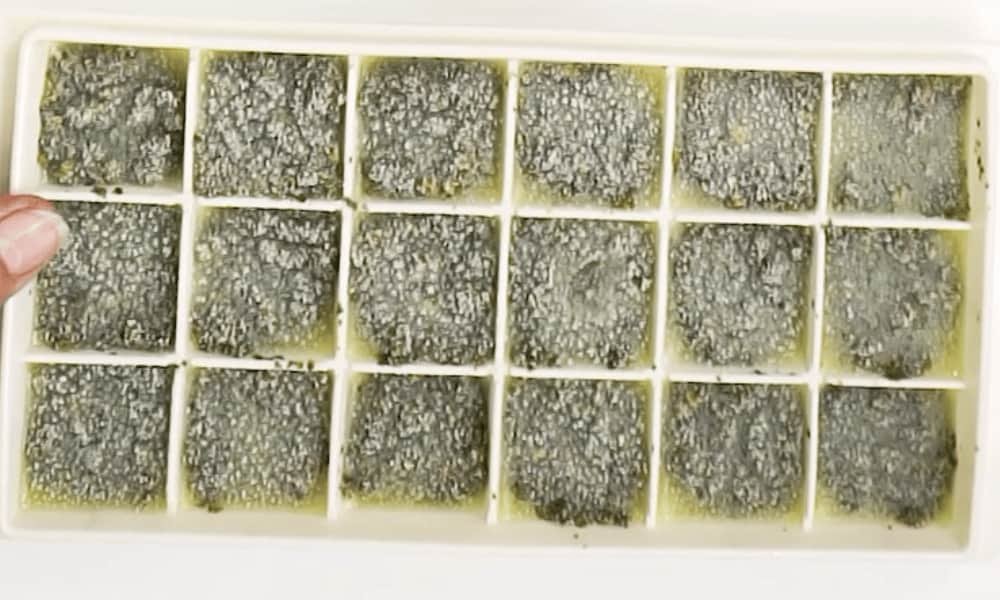If you’re a fan of vegan pesto, you know how versatile and delicious it can be. But what about when you make too much and can’t possibly eat it all before it goes bad? Or what if you want to make a big batch to have on hand for quick and easy meals?
Can You Freeze Vegan Pesto?
Yes, you can freeze vegan pesto for up to 3 months. Place the pesto into a rigid container and press down on the surface to ensure no air bubbles within it. Then, seal the container tightly, and transfer it to the edge of your freezer.
Do Does Vegan Pesto freeze well? Yes
Can you refreeze Vegan Pesto? Yes
How to Freeze Vegan Pesto
Freezing vegan pesto is simple. Here are the steps we’d recommend:
- Transfer: Transfer the vegan pesto into a rigid container, allowing you to stack it more easily. For a zero-waste option, you could use a cleaned glass jar.
- Press Out Buttles: Press out any bubbles from the pesto with the back of a spoon. Air bubbles condense to water and freeze to ice, leading to freezer burn within the pesto.
- Seal: Seal the vegan pesto tightly to prevent any freezer burn from creeping through the seal and into the container. This will prolong the life of the flavour that pesto tends to have.
- Freeze: Freeze the vegan pesto on the edge of your freezer, as there is no real texture that would be damaged by freezer burn. Therefore, it can be stored a little ‘sacrificially’.
The other option you have when freezing vegan pesto is to freeze it into ice cubes. Simply pour the pesto into the slots of an ice cube tray, seal with a drizzle of olive oil and then freeze.
Once the cubes are solid, you can pop them out of the tray and into a freezer bag which can then be returned to the freezer for up to 3 months.

3 Tips for Freezing Vegan Pesto
Now you know how to freeze it, we’ve got our 3 top tips which we strongly recommend following when freezing vegan pesto to have the best results:
Remove Air Bubbles
Ensure that bubbles within the vegan pesto are removed by depressing the surface with the back of a spoon. That will allow you to ensure that no water bubbles form, which would lead to freezer burn removing flavour from the pesto.
Store Upright
Store the container full of pesto upright in your freezer. This will ensure that the chances of spillage are much lower, which could lead to stains with ingredients such as basil or sundried tomato.
Expect Separation
The oil in your pesto will likely separate from the other ingredients as it freezes – don’t be afraid of this. It will thaw well and can then be easily mixed into the pesto.
How Long Can You Freeze Vegan Pesto?
You can freeze vegan pesto for around 3 months before noticing any flavour degradation. This degradation will likely take the form of the pesto simply becoming less intense – though the pesto will still be safe to eat.
The most annoying thing about freezing pesto is it can turn a little brown over time. This won’t impact the flavour but can make it look a little less appetising when stirred through pasta.
When stored in a jar with a tight-fitting lid, vegan pesto will last for around 1 week in the fridge.
How Do You Defrost Vegan Pesto?
You can defrost vegan pesto by allowing it to sit in the fridge overnight and slowly thaw.
We recommend this thawing method as it ensures that the pesto is stored at a safe temperature, at which no bacteria will be liable to grow on the nutrient-rich pesto.
Can You Refreeze Vegan Pesto?
Yes, you can refreeze vegan pesto.
The best way to do this is to use the method we laid out above – ensure there are no air bubbles, seal tightly, and transfer to the edge of the freezer.
Does Vegan Pesto Freeze Well?
Yes, vegan pesto does tend to freeze quite well. The main reason for this is that the pesto itself is dense, so it’s not likely that air pockets would form in it.
It also freezes well because of the high oil content, which reduces the water available in the pesto. This leads to a lower chance of bacterial growth.
Related FAQs
If you’ve still got questions about freezing vegan pesto or pesto in general, then these may help:
Pesto turns brown when air gets into contact with the surface. You can prevent some of this by sealing it in a thin layer of olive oil and storing it in good-quality airtight containers.
Sources
We have verified the information on this page using the following resources:


